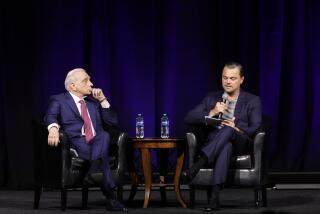Early Films at Cinecon: Magic Flickers Into Being
- Share via
Cinecon 38, the Society for Cinephiles’ convention, is back for its annual presentation of five days of silents and early talkies, most of which hardly anyone, including Cinephiles themselves, have ever heard of, let alone seen.
The whole point is discovery. Practically everything the organization’s board turns up is worth a look--and worth preserving, which is another of the society’s goals.
Cinecon, which opens tonight at the Egyptian, is always open to the public, with passes available for the festival or a single day. Robert Stack is this year’s honoree, and the Renaissance Hollywood Hotel is the host hotel for Cinecon’s special events and memorabilia marketplace.
Among the films Cinecon was able to preview were some gems that are also notable for the impressive quality of their prints. Of historical importance will be the screening of the very first narrative film with scenes shot in Southern California: Francis Boggs’ one-reel 1908 “Monte Cristo” (Saturday at 1:40 p.m.).
Made for the Selig Co., it boils “The Count of Monte Cristo” down to about 15 minutes and, with the exception of a single scene, is but a filmed play divided into acts, complete with the lowering of the curtain. It is fustian melodrama with patently fake sets, and it depends heavily on the audience’s familiarity with the plot.
The movie was shot in Chicago or perhaps New Orleans, but native Californian Boggs returned home to shoot a sequence of Dantes emerging from the sea and struggling to make his way to the safety of some rocks.
With a realism that is startling in contrast to the rest of the film’s artificiality, it is a clear harbinger of the direction the movies would swiftly take.
Last year Cinecon had a surprise hit with “Dangerous Blondes” (1943), directed by Leigh Jason and starring Allyn Joslyn and Evelyn Keyes as husband-and-wife detectives. This year brings Jason’s 1941 “Three Girls About Town” (Saturday at 3 p.m.), a delightful screwball comedy and mystery scripted by Richard Carroll and starring Joan Blondell, Binnie Barnes and Janet Blair in the title roles. Big-city convention hotel hostesses Blondell and Barnes have to cope simultaneously with a wandering corpse and their vacationing younger sister (Blair), eager to protect her while they work hard to pay her college tuition, not realizing she’s an audacious vamp with no interest in higher education.
The two hostesses are working both a morticians’ convention and union arbitration with a defense contractor, striking a serious note in the months before Pearl Harbor. Among the reporters covering the arbitration is Blondell’s cocky fiance, John Howard, with whom she is forever sparring. (The other reporters include an unbilled Lloyd Bridges and Bruce Bennett.)
“Three Girls” is frequently hilarious, the stars shine, and Jason sustains an admirably brisk pace amid a torrent of dialogue and plot complications, involving what seems the lion’s share of Hollywood’s most deft and beloved character actors.
Cinecon programmers believe that with the 1934 film “Bulldog Drummond Strikes Back” (Friday at 7:50 p.m.), they have uncovered the most outstanding unknown Hollywood movie of the ‘30s, and they could be right. In it, Ronald Colman returns as the famous amateur English sleuth he first played in 1929. Director Roy Del Ruth and screenwriter Nunnally Johnson and all others concerned clearly see this mystery as creaky but a great opportunity for fun.
A peculiar odor lures Drummond into a sinister East Asian prince’s (Warner Oland) Gothic-style London mansion, which is the setting for outrageous goings-on. Loretta Young is the film’s lady in distress, and Charles Butterworth very nearly walks off with the movie as Drummond’s hilarious sidekick, Algy, whose wedding night (with Una Merkel) is continually interrupted by Drummond’s summonses for help. Colman plays with an elegant, witty, devil-may-care charm that is timeless.
William S. Hart emerged as the premier western star of the teens, and “White Oak” (1921), which screens Sunday at noon, combines the conventions of full-blown silent melodrama with the star’s well-known concern for authenticity. In a story of his own devising, Hart is the familiar stoic, involved in a westward trek. He is drawn to vivacious Vola Vale, who is about to lose her brother to the same villain responsible not only for the death of Hart’s sister but also for a pending Indian attack.
“White Oak” rambles, as do numerous other silents, but it has a superb pictorial grandeur, thanks to the imagination of director Lambert Hillyer and cinematographer Joe August.
“Emperor Jones” (Friday at 2 p.m.), the 1933 Dudley Murphy-directed film version of the 1920 Eugene O’Neill play, stars Paul Robeson as a naive rural Southerner who lands a job as a Pullman porter, gets caught up in Harlem high life and winds up in an island prison, only to escape and become the dictator of a nearby Caribbean island. There’s not much point to all of this, but Robeson swaggers through impressively. The film has superior art direction and is atmospheric, particularly in its depiction of Harlem night life.
The Egyptian Theatre is at 6712 Hollywood Blvd., Hollywood. For Cinecon 38 information, call (800) 411-0455.
*
Sunset 5 launches “Women in Peril,” a three-weekend, 10 a.m. series, with Jill Morley’s “Stripped,” an incisive documentary about five exotic dancers, including herself. Other filmmakers have dealt with the eternally provocative topic, but few with such depth and clarity.
Morley focused on women like herself: educated, articulate, attractive, from middle-class backgrounds. All five went into it for the money and the comparative freedom and independence. A struggling actress and writer, Morley found stripping a steadier and more rewarding way of supporting herself than a series of menial jobs. She also thought it would be a great learning experience for an actress--and she learned more than she bargained for.
Morley and her other subjects feel conflicted about what they’re doing and how it is affecting their personal lives. They realize it is a profession that is short-lived, but as Morley discovers, it can also be addictive, as a lucrative occupation and as one that confers an intoxicating power over men. Just when it seems that these women are in control of their destinies, “Stripped” pulls a double whammy at its climax that gives it an unexpectedly darker and disturbing dimension.
The Sunset 5 is at 8000 Sunset Blvd., West Hollywood, (323) 848-3500.
*
The Laemmle Theaters’ Documentary Days series continues at the Sunset 5 with Saturday, Sunday and Monday 10 a.m. screenings of the irresistible “Drive-In Movie Memories,” directed by Kurt Kuenne. It’s based on the book of the same name by the film’s producers, Don and Susan Sanders, as well as their other book, “American Drive-In Movie Theater.”
Steeped in nostalgia for a simpler, more innocent and communal time, “Drive-In Movie Memories” is amazingly comprehensive and chock-full of information for a film that clocks in at 58 minutes.
Camden, N.J., businessman R.J. Hollingshead Jr. opened the first drive-in on June 6, 1933; legend has it that he was inspired to do so because Hollingshead Sr. was too obese to fit into theater seats.
It was a hit from the start, and drive-ins, mainly primitive mom-and-pop operations, began opening up all over the country. Drive-ins took off in a big way after World War II, becoming corporate ventures, with as many as 700 theaters opening in 1947 and 1948.
Television made a dent in what Variety dubbed “ozoners” just as it did “hardtops,” but drive-ins got a new lease on life in the late ‘50s and early ‘60s when American International Pictures’ Samuel Z. Arkoff and James Nicholson and others started making inexpensive exploitation movies expressly for teen audiences.
The rise of the shopping mall multiplex and the advent of the VCR did in drive-ins, but there has been a modest revival across the country in recent years, with about 40 ozoners either reopened or newly constructed.
The film is laced with drive-in promotional trailers and archival materials, as well as the reminiscences of producers, exhibitors and distributors, plus such drive-in movie stars as Beverly Garland, Celeste Yarnall and Robert Fuller, who are represented by deliciously lurid trailers for their films.
“Drive-in Movie Memories” is as affectionate as it is informative, and a valuable work of social history and popular culture.
“Drive-In Movie Memories” will screen at 11 a.m. Sept. 7 and 8 at the Monica 4-Plex, Santa Monica, (310) 394-9741; Sept. 14 and 15 at the Playhouse 7, Pasadena, (626) 844-6500; and Sept. 21 and 22 at the Fallbrook, West Hills, (818) 340-8710.
More to Read
Only good movies
Get the Indie Focus newsletter, Mark Olsen's weekly guide to the world of cinema.
You may occasionally receive promotional content from the Los Angeles Times.







